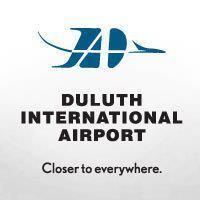Airport type Public Code DLH Phone +1 218-727-2968 | Elevation AMSL 1,428 ft / 435 m Elevation 435 m Passenger count 266,500 | |
 | ||
Operator Duluth Airport Authority Location St Louis County, Minnesota, USA Address 4701 Grinden Dr, Duluth, MN 55811, USA Profiles | ||
Duluth international airport
Duluth International Airport (IATA: DLH, ICAO: KDLH, FAA LID: DLH) is a city owned, public use joint civil-military airport located five nautical miles (9 km) northwest of the central business district of Duluth, a city in Saint Louis County, Minnesota, United States. It serves the Twin Ports area, including Superior, Wisconsin. It is mostly used for general aviation but is also served by three commercial airlines. It is the third-busiest airport in Minnesota, behind Minneapolis–St. Paul International Airport (MSP) and Rochester International Airport; and the second-busiest commercial passenger airport in Minnesota, behind MSP.
Contents
The Minnesota Air National Guard's 148th Fighter Wing, equipped with F-16C Fighting Falcons, is based at Duluth Air National Guard Base.
History
The City of Duluth purchased the original property for the airport in 1929 from Saint Louis County. The airport was constructed on 640 acres (2.6 km2) of land with two 2,650-foot (810 m) sod runways. In 1930, the airfield was dedicated as Williamson–Johnson Municipal Airport.
In 1940, Northwest Airlines began the first regularly scheduled air service to Duluth. Two years later, operations were temporarily halted by World War II.
In 1942, the three existing runways were paved. Each runway was 4,000 feet (1,200 m) long, 150 feet (46 m) wide, and at nearly equal angles from each other, 30, 90, and 130 degrees. They were identified as runways 3–21, 9–27, and 13–31 respectively. The Corps of Engineers extended Runways 9–27 and 3–21 to 5,699 feet (1,737 m) in 1945. In 1951, the USAF extended Runway 9–27 to 9,000 feet (2,700 m) with a 1,000-foot (300 m) overrun and the control tower was built. Runway 9–27 was rebuilt in 1956 and extended in 1966 to 10,152 feet (3,094 m) in length.
The original terminal building was built in 1954, south of Runway 9–27 and west of Runway 3–21. The terminal floor area was 14,200 square feet (1,320 m2) with 280 parking spaces. It would serve the airport for nearly 20 years.
In 1961, the Duluth Airport Authority Board renamed the facility Duluth International Airport.
In 1973, a new Terminal Building and U.S. Customs, International Arrivals Building, were completed east of Runway 13–31 and opened for operation. Runway 13–31 was shortened to 2,578 feet (786 m) to accommodate construction of an addition to the International Arrivals building. This resulted in Runway 13–31 being closed as a runway due to obstructions. Runway 13–31 was re-striped in 1980, decreasing its width to 75 feet (23 m), for use as a taxiway. In 1989, the newer terminal building and the adjacent structures were connected to form one enclosure. The original terminal building was then converted for use as offices for general aviation, the FAA, and the U.S. Weather Bureau. The 1973 terminal building had its last flight take place on January 13, 2013.
In 2013, a new passenger terminal was built directly in front of the 1973 terminal. This new building solved several problems of the previous terminal building, including that the tails of parked airplanes extended too close to the runway due to FAA airspace changes made after the building's completion. This terminal building has restrooms and concessions beyond the TSA security checkpoint, something the previous terminal lost when screening processes were put in place added 9/11. The first flight to leave the new terminal was on January 14: United flight 5292 to Chicago O'Hare.
On October 30, 2015, the new terminal was named for the late U.S. Representative Jim Oberstar, who represented the congressional district in which the airport lies from 1975 - 2011 and helped secure funding for the facility before its 2013 opening.
A 370-stall parking ramp with skywalk connection to the terminal was completed in fall 2014.
Facilities and aircraft
Duluth International Airport covers an area of 3,020 acres (1,220 ha) at an elevation of 1,428 feet (435 m) above mean sea level. It has two runways: 9/27 is 10,162 by 150 feet (3,097 m × 46 m) with a concrete surface and 3/21 is 5,719 by 150 feet (1,743 m × 46 m) with an asphalt surface.
For the year ending June 30, 2007, the airport had 67,752 aircraft operations, an average of 185 per day: 76% general aviation, 10% military, 8% air taxi and 6% scheduled commercial. In January 2017, there were 86 aircraft based at this airport: 49 single-engine, 10 multi-engine, 3 jet, 3 helicopter and 21 military.
